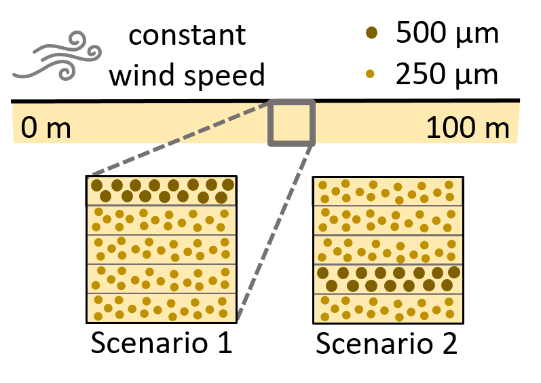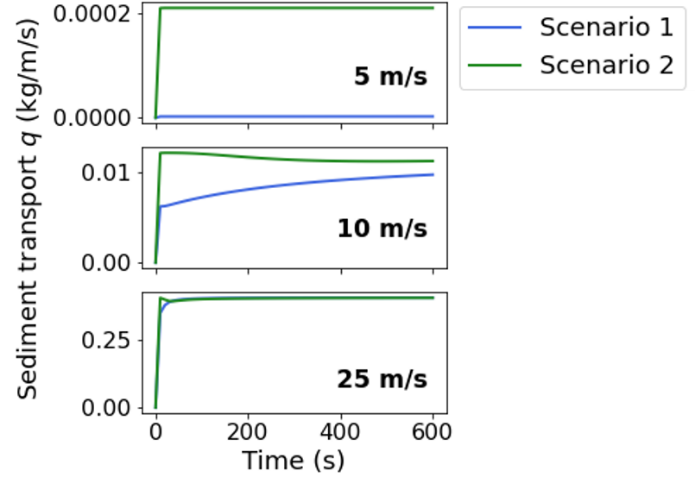C.O. van IJzendoorn1*, C. Hallin1 2, S. de Vries1
1 TU Delft,
2 Lund University
Introduction
Aeolian sediment transport determines the growth and development of coastal dunes. Many factors, including grain size, influence the amount of sediment transported towards the dunes. Recently, it was shown that significant variations in vertical grain size layering occur at the millimetre scale on the beach (van IJzendoorn et al., 2022). It is expected that this layering could affect the aeolian sediment transport towards the dunes. However, vertical grain size variability at this scale is typically not accounted for in grain size sampling or when predicting aeolian transport. This study uses a numerical model to investigate how different vertical sequences of fine and coarse sand layers affect aeolian transport.
Methods
Cases with varying vertical grain size layering were used as input for the numerical aeolian sediment transport model Aeolis (Hoonhout and de Vries, 2016). The beach surface used in the calculations was 100 m long, and a 10-minute constant wind speed was imposed. The grain size layering at the beach surface was represented by 5 layers, consisting of either fine (250 μm) or coarse (500 μm) sand. Here, we display two scenarios in which the vertical placement of a coarse layer varied (Figure 1). Constant wind speeds of 5, 10, and 25 m/s were applied. The aeolian sediment transport was calculated to determine the effect of the varying vertical grain size layering and wind speed.
Results and discussion
The results show that vertical grain size layering can directly affect the amount and timing of aeolian transport. At a wind speed of 5 m/s, no transport occurred in scenario 1 because the wind was not strong enough to mobilize the top layer of coarse sand. However, in scenario 2, transport did occur because fine sand was available at the surface. At 10 m/s, the wind moved coarse sand from the top layer in scenario 1. Thus, fine sand became available near the surface, and the transport increased through time. On the contrary, for scenario 2, the fine sand depleted over time, and the presence of coarse sand decreased the transport. At 25 m/s, both the fine and coarse sand was easily mobilized and transported by the wind, resulting in similar transport for scenarios 1 and 2. These simplified academic cases are expanded to real-world scenarios to estimate the effects of grain size layering on the total aeolian sediment transport towards the dunes on yearly timescales.

Figure 1: The vertical grain size layering as implemented in scenario 1 and 2 in Aeolis.

Figure 2: Aeolian transport (at x = 100 m) calculated using Aeolis for scenarios 1 and 2.
References
Van IJzendoorn, Hallin, Cohn, de Vries. (2022). Measurements of vertical grain size variability in the intertidal zone due to marine and aeolian processes. Manuscript submitted for publication.
Hoonhout, B. M., & Vries, S. D. (2016). A process‐based model for aeolian sediment transport and spatiotemporal varying sediment availability. Journal of Geophysical Research: Earth Surface, 121(8), 1555-1575.
I. Surname1*, F.N. Another-Surname2 , Y. Next-Surname2
1 University Name, Country; 2 Organization Name, Country
* Corresponding author: mail.name@organization.org


